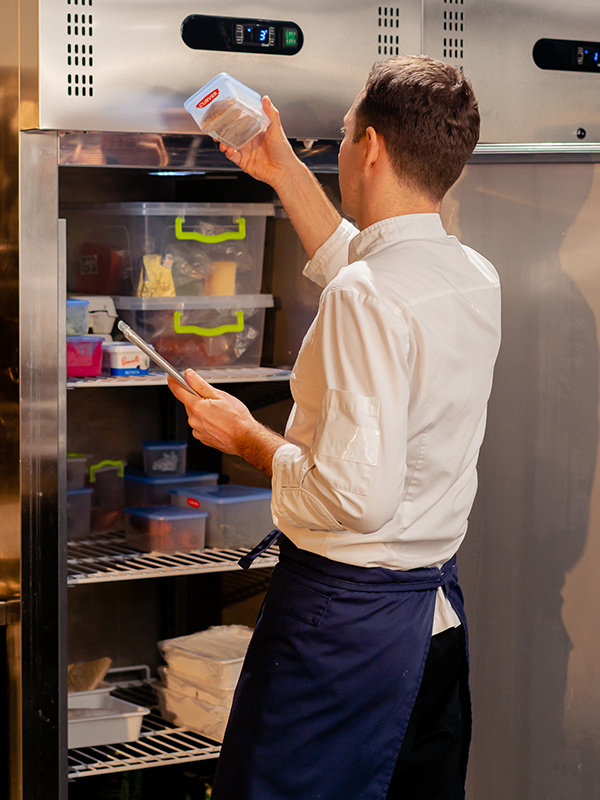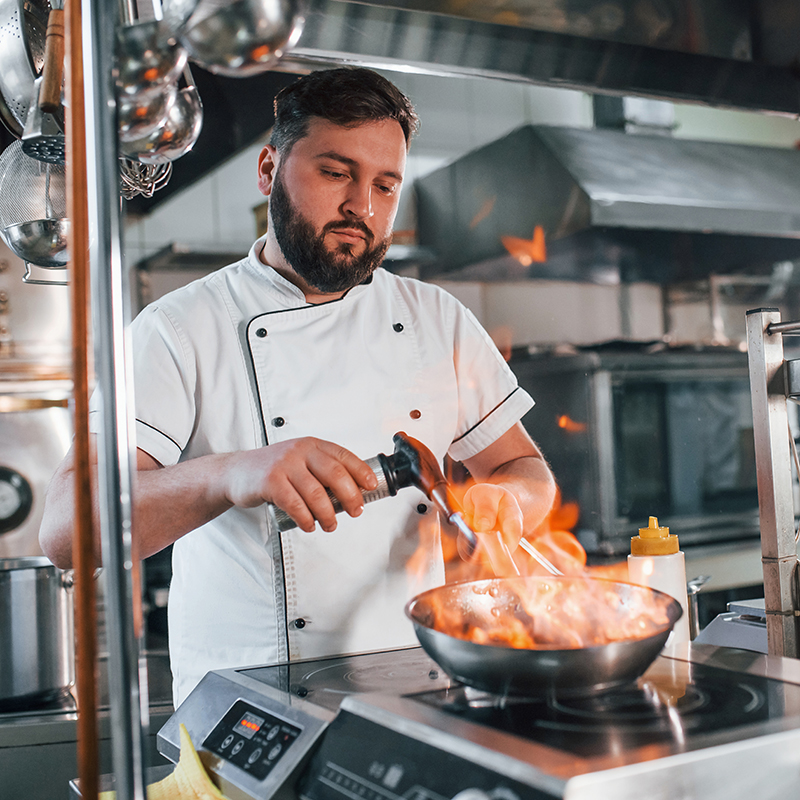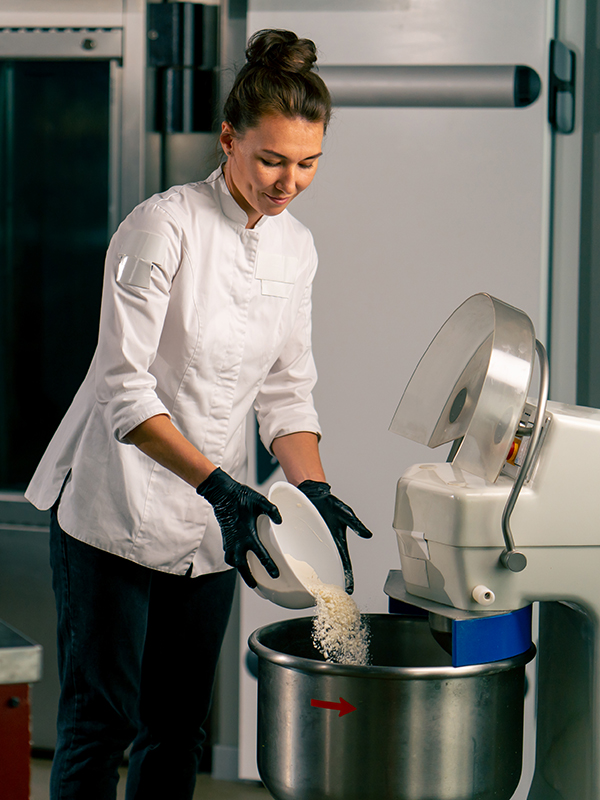Enhancing
Food Safety
Far-UV 222nm technology for catering
and food preparation
The modern way to maintain hygiene
In the catering and food preparation industry, maintaining a high level of hygiene is essential to prevent foodborne illnesses and protect the health of consumers. Traditional cleaning methods can be time-consuming and may not always be effective in eliminating harmful pathogens. Far-UVC technology offers a more efficient and effective solution for ensuring food safety and hygiene.

Reduction in SARS – CoV-2
Reduction in SARS – CoV-2
Reduction in SARS – CoV-2
Reduction in SARS – CoV-2
Maintaining stringent food safety practices is crucial in catering, where food preparation and service can be vulnerable to various pathogens. Here are some key pathogens commonly associated with food safety concerns in this sector:
Bacteria
Salmonella spp.: This bacterial genus is frequently associated with raw poultry, eggs, and dairy products. Inadequate cooking or improper handling can lead to foodborne illness caused by Salmonella spp., posing a significant risk to public health within food service environments.
Escherichia coli (especially O157:H7): Certain strains of Escherichia coli, particularly O157:H7, represent a serious food safety concern. These bacteria can be present in undercooked ground beef and contaminated vegetables, causing severe gastrointestinal distress and potentially life-threatening complications.
Listeria monocytogenes: This bacterium is commonly found in ready-to-eat foods, deli meats, and unpasteurized dairy products. Listeria monocytogenes poses a heightened risk to vulnerable populations, including pregnant women and immunocompromised individuals, and can cause severe illness.
Campylobacter spp.: This bacterial genus is a common cause of foodborne illness, frequently linked to the consumption of contaminated poultry. Proper handling and cooking are crucial to mitigate the risk of Campylobacter spp. infection in food service settings.
Staphylococcus aureus: This bacterium can proliferate in improperly stored food and is notable for producing heat-stable toxins. Even after cooking, these toxins can remain active and cause food poisoning, highlighting the importance of proper food storage and handling practices.
Viruses
Norovirus: This highly contagious virus is a significant concern in catering environments due to its ease of transmission through contaminated food, surfaces, and direct person-to-person contact. Norovirus outbreaks are frequently associated with ready-to-eat foods, emphasizing the need for robust hygiene and sanitation protocols.
Hepatitis A Virus (HAV): Hepatitis A is a viral liver infection that can be transmitted through contaminated food and water. Consumption of contaminated shellfish and fresh produce is a common route of transmission, posing a risk to public health within the food service industry.
Parasites
Giardia spp.: This parasitic protozoan is commonly transmitted through contaminated water and food, causing giardiasis, a gastrointestinal illness characterized by diarrhea, abdominal cramps, and nausea. Maintaining proper sanitation and water treatment practices is crucial to prevent Giardia spp. contamination in food service settings.
Trichinella spp.: Infection with Trichinella spp., the parasitic roundworm responsible for trichinosis, is primarily associated with the consumption of undercooked or raw meat, particularly pork and game meats. Thorough cooking to appropriate internal temperatures is essential to eliminate the risk of trichinosis in food preparation.
Fungi
Moulds and Yeasts: Certain moulds are capable of producing mycotoxins, toxic secondary metabolites that can contaminate food and pose significant health risks. Additionally, various yeasts can contribute to food spoilage, leading to undesirable changes in taste, texture, and appearance, or cause fermentation-related issues affecting food quality and safety. Effective control measures are essential to mitigate the risks associated with mould and yeast contamination in food processing and storage environments.

Improving Kitchen Sanitation
Far-UVC can be used to disinfect a variety of surfaces in commercial kitchens, including countertops, cutting boards, utensils, and equipment. By eliminating bacteria, viruses, and other contaminants, Far-UVC can help prevent the spread of foodborne illnesses.
- Surface disinfection: Far-UVC can be used to disinfect food preparation surfaces, reducing the risk of cross-contamination.
- Equipment sterilization: Far-UVC can also be used to sterilize kitchen equipment, such as knives, blenders, and mixers.
- Storage area sanitation: Far-UVC can be used to disinfect storage areas, preventing the growth of mold and mildew.
Enhancing Air Quality
In addition to surface disinfection, Far-UVC can also be used to improve air quality in commercial kitchens. By eliminating airborne pathogens, Far-UVC can help create a healthier and safer environment for both staff and customers.
- Air purification: Far-UVC can be used to purify the air in kitchens, reducing the risk of airborne transmission of foodborne pathogens.
- Odor control: Far-UVC can also help control odors in kitchens, improving the overall environment.


Benefits for Catering Businesses
By implementing Far-UVC technology, catering businesses can:
- Improve food safety: Reduce the risk of foodborne illnesses and protect the health of consumers.
- Enhance reputation: Demonstrate a commitment to food safety and hygiene.
- Increase efficiency: Streamline cleaning and sanitation processes.
- Reduce costs: Lower the cost of cleaning supplies and labour.
- Far-UVC light has been shown to reduce the prevalence of airborne norovirus and other viruses. A study demonstrated the effectiveness of far-UVC light in reducing the spread of airborne norovirus and other viruses. Researchers found that 222 nm far-UVC light reduced airborne murine norovirus (MNV) by 99.8% in a mouse-cage cleaning room. MNV serves as a reliable model for human viruses like influenza and coronavirus.
In summary
Far-UVC technology offers a powerful tool for improving food safety and hygiene in the catering and food preparation industry. By effectively disinfecting surfaces and enhancing air quality, Far-UVC can help create a safer and healthier environment for both staff and customers.
FAQs
Any further questions?
Our expert team are on hand to answer any questions about our Far-UVC solutions and how they could be best integrated within your business set up.

Registered Office: Unit 6, Old School House, School Street, Pontyclun, CF72 9FF, Wales, United Kingdom
Operational Sites: Wales, West Country & East Anglia
Company Number: 13791266
D-U-N-S Number: 228512382
VAT Number: GB 448730277